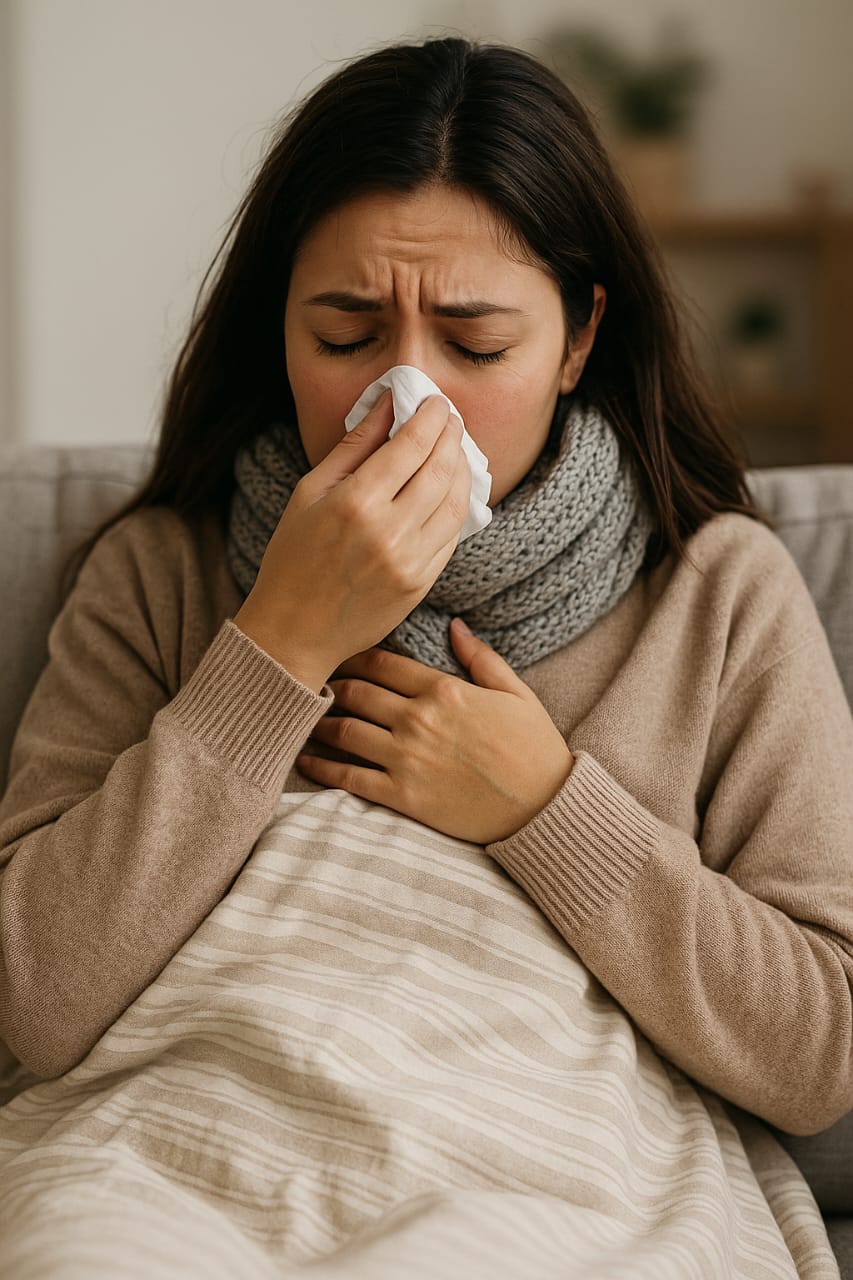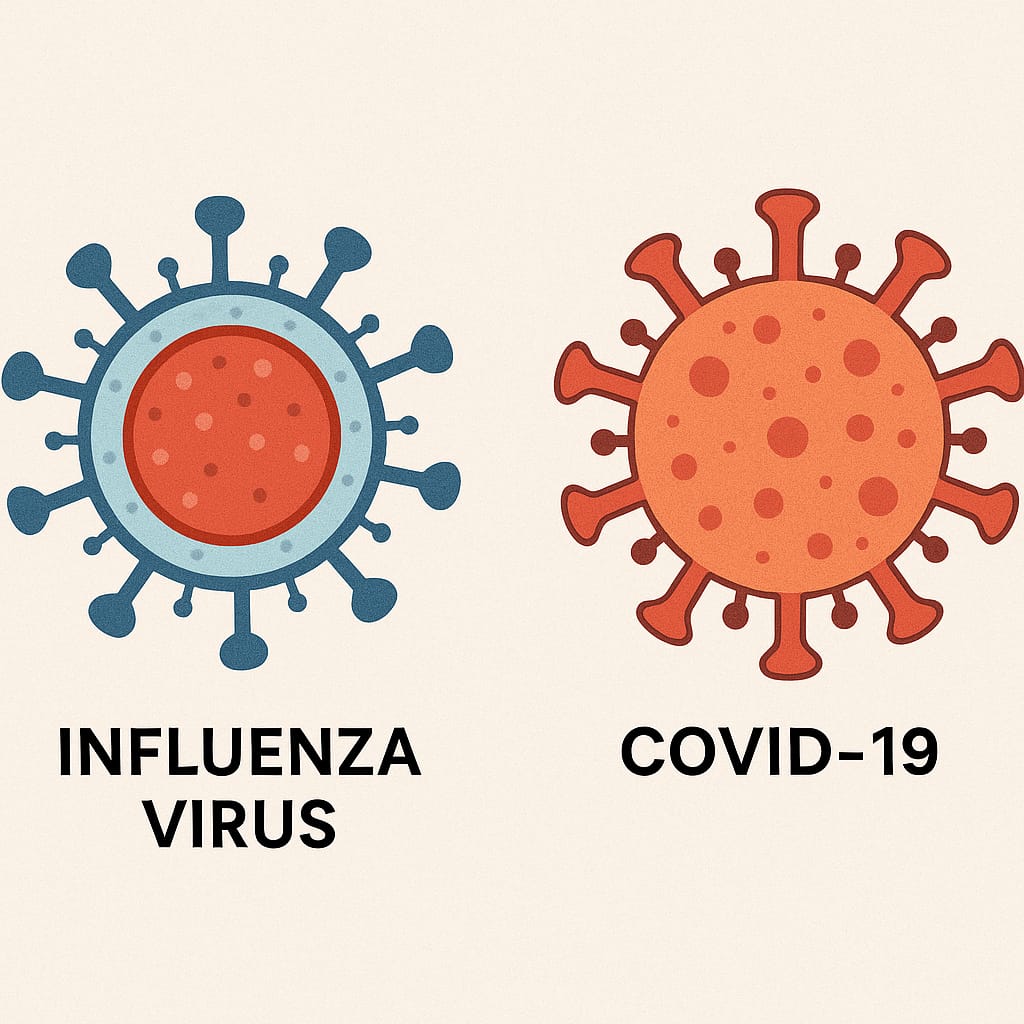Seasonal Flu vs. COVID: Key Medical Differences


Introduction
Respiratory illnesses are among the most common reasons for patient visits, especially during seasonal peaks. Both seasonal influenza (flu) and COVID-19, caused by SARS-CoV-2, share overlapping symptoms, yet they differ significantly in transmission dynamics, severity, complications, and public health impact. For physicians, clear differentiation is essential—not just for academic clarity, but for timely intervention and prevention of complications.
General Readers
For the general population, it is important to know that while both flu and COVID can cause fever, cough, sore throat, fatigue, and body aches, COVID tends to cause loss of taste and smell, more prolonged fever, and breathing difficulties in moderate to severe cases. Flu usually comes on abruptly and resolves within 5–7 days in healthy individuals, while COVID often has a longer course and a higher likelihood of complications such as pneumonia, clotting problems, and post-infectious syndromes.
Key practical point: If you develop shortness of breath, chest pain, or persistent high fever, you must seek medical attention immediately.

Medical Students
From an academic standpoint, both influenza viruses (mainly Influenza A and B) and SARS-CoV-2 are RNA viruses, but they belong to different families. Influenza belongs to the Orthomyxoviridae family, while SARS-CoV-2 is a Betacoronavirus.
Pathophysiology differs:
• Flu: Rapid viral replication damages the respiratory epithelium, leading to acute symptoms and bacterial superinfection risk.
• COVID: Apart from respiratory tract involvement, it triggers ACE2 receptor–mediated systemic inflammation, endothelial dysfunction, and cytokine storm, explaining its cardiovascular, thrombotic, and neurological complications.
Epidemiologically, flu has a well-defined seasonal pattern, while COVID has shown pandemic waves and persistent circulation.
Young Doctors
In clinical practice, the challenge is to differentiate early and manage promptly:
• Symptom Overlap: Both cause fever, cough, malaise, but anosmia and dysgeusia point toward COVID.
• Incubation Period: Flu—1 to 4 days; COVID—2 to 14 days (average 5–6 days).
• Severity: COVID carries a higher risk of ARDS, thromboembolic events, and long-term sequelae (Long COVID).
• Diagnostics:
• Rapid influenza antigen tests or PCR for flu.
• RT-PCR, antigen, or NAAT for COVID.
• Treatment:
• Flu: Neuraminidase inhibitors (oseltamivir) in selected cases.
• COVID: Supportive care, antivirals (e.g., remdesivir in moderate-severe cases), corticosteroids in hypoxemic patients, and anticoagulation where indicated.
• Prevention: Vaccination is crucial for both; however, COVID vaccination has shown greater impact in preventing severe illness and hospitalization.
General Practitioners
For frontline physicians, distinguishing flu from COVID has direct implications:
• History: Exposure history (family, workplace, travel), vaccination status, sudden vs. gradual onset.
• Clinical Course: Flu patients generally recover in a week, while COVID may linger.
• Complications:
• Flu: bacterial pneumonia, otitis media, myocarditis (rare).
• COVID: ARDS, pulmonary fibrosis, thromboembolism, myocarditis, and long COVID.
• Public Health Measures: Isolation protocols differ—COVID requires more stringent infection control due to higher transmissibility.
• Practice Tip: When in doubt, test for both—dual infection is possible and has been documented.
When to See the Doctor
• Persistent or worsening shortness of breath
• High fever not responding to medication
• Chest pain or palpitations
• Confusion or altered sensorium
• Oxygen saturation <94% on room air
• Severe dehydration, especially in elderly and children
Early consultation prevents progression and reduces mortality.
Conclusion
Seasonal flu and COVID-19, though clinically similar in their initial presentation, differ markedly in pathophysiology, severity, complications, and management strategies. Physicians must rely on careful history, diagnostic tools, and vigilant monitoring to differentiate and treat effectively. For the general population, the message remains simple: Vaccination, preventive hygiene, and early medical consultation are the strongest defenses against both.
Pathophysiology: Seasonal Flu vs. COVID-19
Seasonal Influenza (Flu)
Influenza viruses (primarily Influenza A and B) belong to the Orthomyxoviridae family. They are negative-sense, single-stranded RNA viruses. The pathophysiological process unfolds as follows:
Viral Entry
• Transmission occurs via respiratory droplets and aerosols.
• The virus attaches to epithelial cells of the upper and lower respiratory tract through hemagglutinin (HA) binding to sialic acid receptors.
• Replication & Epithelial Damage
• Following endocytosis, viral replication damages respiratory epithelial cells, impairing mucociliary clearance.
• This disruption predisposes to secondary bacterial infections (e.g., Streptococcus pneumoniae, Staphylococcus aureus).
Immune Response
• Symptoms such as fever, myalgia, and malaise are mediated by pro-inflammatory cytokines (IL-1, IL-6, TNF-α).
• Local inflammation produces sore throat and cough.
Resolution vs. Complications
• In most healthy individuals, the immune response clears the infection within 5–7 days.
• In vulnerable patients, complications include viral pneumonia, bacterial superinfection, myocarditis, and encephalitis.
COVID-19 (SARS-CoV-2)
COVID-19 is caused by SARS-CoV-2, a positive-sense, single-stranded RNA virus from the Coronaviridae family. Its pathophysiology is broader and more systemic than flu:
• Viral Entry via ACE2 Receptors
• The virus binds to angiotensin-converting enzyme 2 (ACE2) receptors, which are expressed not only in the respiratory tract but also in the endothelium, myocardium, kidneys, and gastrointestinal tract.
• This explains the multi-system involvement beyond the lungs.
Pulmonary Involvement
• Infection of alveolar type II pneumocytes impairs surfactant production, causing alveolar collapse.
• Diffuse alveolar damage and hyaline membrane formation lead to acute respiratory distress syndrome (ARDS).
Immune Dysregulation
• In some patients, a cytokine storm (excess IL-6, TNF-α, IL-1β) occurs, causing severe systemic inflammation, vascular leakage, and multi-organ dysfunction.
• This explains the disproportionate severity compared to influenza.
• Endothelial Dysfunction and Coagulopathy
• Viral binding to endothelial ACE2 receptors causes endothelial injury, complement activation, and hypercoagulability.
• Results: microthrombi, pulmonary embolism, stroke, myocardial infarction.
Systemic Complications
• Beyond respiratory symptoms, patients may develop cardiac injury, acute kidney injury, GI symptoms, neurological effects, and long COVID syndromes due to persistent immune activation and tissue damage.
Key Differences in Pathophysiology
• Target Receptors: Flu affects respiratory epithelium (sialic acid), while COVID affects multiple systems via ACE2 receptors.
• Tissue Damage: Flu causes epithelial shedding and bacterial superinfection, while COVID leads to diffuse alveolar damage, endothelial dysfunction, and thrombosis.
• Immune Response: Flu generates a typical antiviral cytokine response, whereas COVID may progress to cytokine storm with multi-organ impact.
• Complications: Flu → secondary bacterial pneumonia; COVID → ARDS, clotting, long-term systemic effects.
This pathophysiological explanation highlights why COVID is clinically more severe and unpredictable compared to seasonal flu, even though both start with similar upper respiratory symptoms.
